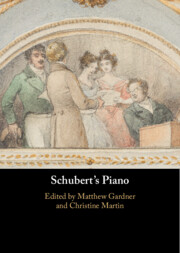Book contents
- Schubert’s Piano
- Schubert’s Piano
- Copyright page
- Contents
- Figures
- Tables
- Music Examples
- Notes on Contributors
- Acknowledgements
- Abbreviations and Conventions
- Introduction
- Part I The Piano in Schubert’s World
- Part II Instruments and Performance
- Part III Sound and Musical Imagery
- 8 Schubert as Balladeer
- 9 The Piano and Musical Imagery in Schubert’s Lieder
- 10 Franz Schubert, Death and the Gothic
- 11 Una Corda: Beethoven’s and Schubert’s Exploration of the Piano’s Sonority as a Structural Resource
- Part IV Understanding Schubert’s Writing for the Piano
- Select Bibliography
- Index
8 - Schubert as Balladeer
from Part III - Sound and Musical Imagery
Published online by Cambridge University Press: 31 August 2024
- Schubert’s Piano
- Schubert’s Piano
- Copyright page
- Contents
- Figures
- Tables
- Music Examples
- Notes on Contributors
- Acknowledgements
- Abbreviations and Conventions
- Introduction
- Part I The Piano in Schubert’s World
- Part II Instruments and Performance
- Part III Sound and Musical Imagery
- 8 Schubert as Balladeer
- 9 The Piano and Musical Imagery in Schubert’s Lieder
- 10 Franz Schubert, Death and the Gothic
- 11 Una Corda: Beethoven’s and Schubert’s Exploration of the Piano’s Sonority as a Structural Resource
- Part IV Understanding Schubert’s Writing for the Piano
- Select Bibliography
- Index
Summary
Schubert’s twenty-eight ballads provide an unusual perspective on his approach to writing for the piano for several reasons. First, the role of improvisation within balladeering was much more pronounced, traces of which remain within Schubert’s published works. Second, the piano was used to provide more explicit scene-setting, through the use of scenic effects, than is generally the case in Schubert’s other Lieder. Third, the ballads allow for the re-examination of narrative processes within nineteenth-century Lieder – in other words, how songs told stories.This chapter focuses on three ballads that show Schubert adopting different approaches to rendering poetic imagery in musical terms. It begins with his 1815 settings of Friedrich Schiller’s ‘Der Taucher’, D77, and Ludwig Heinrich Christoph Hölty’s ‘Die Nonne’, D212, considering their use of elaborate ‘Schauder’ or ‘shudder’ effects, which now tend to be dismissed as hackneyed but might instead be considered to offer access to often-overlooked aspects of early nineteenth-century performance culture. At the other end of the stylistic spectrum, and of Schubert’s career, comes his simple strophic setting of Gottfried Herder’s ‘Edward’, D923 (1827). Concepts and practices of the ballad shifted over the course of Schubert’s career and would continue to do so for subsequent generations.
- Type
- Chapter
- Information
- Schubert's Piano , pp. 161 - 179Publisher: Cambridge University PressPrint publication year: 2024

